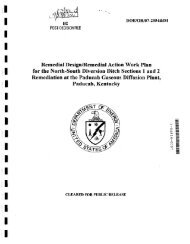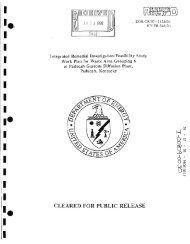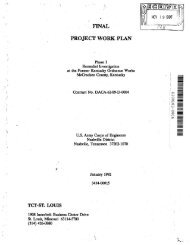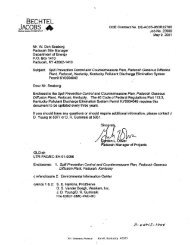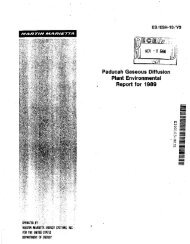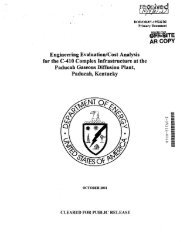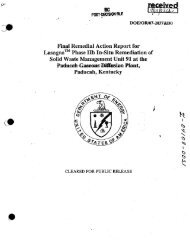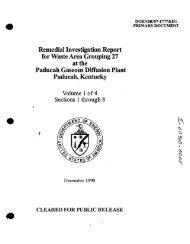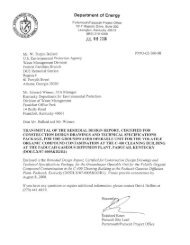1 - paducah environmental information center
1 - paducah environmental information center
1 - paducah environmental information center
Create successful ePaper yourself
Turn your PDF publications into a flip-book with our unique Google optimized e-Paper software.
Paducah Site<br />
i<br />
D-8<br />
downgradient well on the east side of the plume<br />
(MW242) remain above 100 11g/L.<br />
North Well Field<br />
The monitoring well data for the north well<br />
field suggest that, like the South Well Field, the<br />
North Well Field is more effective in capturing<br />
the west side of the plume than the east side. The<br />
two downgradient wells on the east side of the<br />
plume have shown steady increases in TCE<br />
concentrations to over 1000 11g/L over the past<br />
year and a half. For the last half of 1999, most of<br />
the wells in the North Well Field have shown an<br />
increase in TeE concentrations,suggesting the<br />
possibility that a volume of groundwater<br />
containing a higher concentration of TCE is<br />
beginning to migrate through the area.<br />
5.2.2 Technetium-99<br />
South Well Field<br />
Groundwater analyses for monitoring<br />
wells of the South Well Field convincingly<br />
demonstrate capture of the ~ 900 pCiIL plume<br />
centroid. In general, the extraction well field is<br />
apparently capturing the west side of the plume<br />
(~ 25 pCiIL) although groundwater containing<br />
several hundred pCiIL 99Tc is migrating past the<br />
east side of the well field.<br />
During December 1999, monitoring<br />
wells MW-245 (on the west side of the well field)<br />
and MW-248 (located between the two<br />
extraction wells) experienced a sharp increase in<br />
99Tc levels. Contaminant trends suggest these<br />
detections are an aberration that will not be<br />
repeated. However, it remains possible that CY<br />
2000 analyses may suggest a significant shift of<br />
the pillme centroid to the west. Groundwater<br />
monitoring results will continue to be assessed to<br />
evaluate shifts in the plume location.<br />
North Well Field<br />
Although less definitive, 99Tc analyses<br />
for the North Well Field suggest that the<br />
extraction wells (particularly EW 229) are<br />
capturing the > 900 pCilL centroid. It appears<br />
that both extraction wells, together, probably<br />
capture the west side of the plume. Technetium-<br />
99 activities of> 500 pCiIL continue to migrate<br />
past the east side of the well field.<br />
The analyses of 1999 reveal a slight<br />
increase in Y9Tc activity on the west side of the<br />
plume during the fourth quarter. Technetium-99<br />
levels in monitoring wells on the east side of the<br />
well field continue a trend begun in 1998 of<br />
sharply increased acti vity.<br />
6. USES OF THIS REPORT<br />
This evaluation of groundwater<br />
contaminant trends for CY 1999 supports<br />
several goals of the PGDP <strong>environmental</strong><br />
program. Foremost, the updated plume maps<br />
and definition of trends will be used in the<br />
preparation of the Groundwater Operable Unit<br />
Feasibility Study to provide the following<br />
<strong>information</strong>:<br />
• define additional areas contributing<br />
significant contamination to the RGA,<br />
• scope the dimensions of potential<br />
remedial actions, and<br />
• refine the extent of off-site areas that<br />
will be addressed by temporary or<br />
permanent institutional controls.<br />
This same assessment will support the<br />
ongoing evaluation of the adequacy of DOE's<br />
Water Policy and effectiveness of the PGDP<br />
groundwater monitoring program. To this end,<br />
this report will be included as an appendix to the<br />
1999 Annual Site Environmental Report. In<br />
addition, the trends and extent of contamination<br />
defined by this report will help identify areas of<br />
groundwater/surface water interaction to be<br />
considered in the upcoming RI of the Surface<br />
Water Operable Unit.<br />
Appendix D



